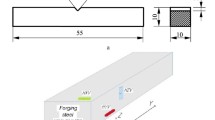High-strength and armored steels are used in different structural elements and in the development of new military equipment operating under extreme conditions, including high-velocity impact interaction and explosive loading. Under such conditions, the fracture is induced by the combination of different mechanisms that depend on the mechanical properties of materials, strain rate, stress state, temperature, etc. Experimental and computational research methods combine to gain additional information on the behavior of high-strength materials essential for modern military equipment in operation. The test results for the penetration of ARMOX 500T steel target 10 mm thick at different loading rates using a ballistic pendulum are presented. The results of a set of piercing tests with the strikers of three types became the basis for evaluating the integral energy characteristics of material deformation and fracture induced by impact interaction; the target penetration pulse against loading rate was constructed and used in the numerical simulation of impact interaction and validation of model material parameters. The finite element method was employed to numerically simulate the processes of dynamic target penetration with the Johnson-Cook material deformation model. The loading and strain rate effects on the results are estimated. The calculation results are compared with experimental data.










Similar content being viewed by others
References
V. V. Astainin and G. V. Stepanov, “Energy characteristics of failure for an aluminum plate with punching by a steel striker,” Strength Mater, 15, 1468–1471 (1983). https://doi.org/https://doi.org/10.1007/BF01523330
Popławski, P. Kędzierski, and A. Morka, “Identification of Armox 500T steel failure properties in the modeling of perforation problems,” Mater Design, 190, 1–28 (2020).
M. A. Iqbal, K. Senthil, P. Sharma, and N. K. Gupta, “An investigation of the constitutive behavior of Armox 500T steel and armor piercing incendiary projectile material,” Int J Impact Eng, 96, 146–164 (2016).
S. Choudhary, P. Singh, S. Khare, et al., “Ballistic impact behaviour of newly developed armour grade steel: An experimental and numerical study,” Int J Impact Eng, 140, 103557 (2020).
G. V. Stepanov and V. I. Zubov, “Analysis of the aluminum alloy resistance to the penetration of a steel rod at impact velocities of up to 500 m/s,” Strength Mater, 30, 536–539 (1998). https://doi.org/https://doi.org/10.1007/BF02522637
S. S. Burov, Design and Calculation of Tanks [in Russian], VA BTV, Moscow (1973).
G. V. Stepanov and V. V. Kharchenko, “Influence of the dynamic behavior of materials on the penetration of long rods at elevated velocities. Discussion,” Strength Mater, 30, 383–392 (1998). https://doi.org/https://doi.org/10.1007/BF02524713
J. A. Zukas, T. Nicholas, H. F. Swift, et al., Impact Dynamics, Wiley (1982).
G. R. Johnson and W. H. Cook, “Fracture characteristics of three metals subjected to various strains, strain rates, temperatures and pressures,” Eng Fract Mech, 21, 31–48 (1985).
G. Cowper and P. Symonds, Strain-Hardening and Strain-Rate Effects in the Impact Loading of Cantilever Beam, Technical Report No. 28, Brown University, Division of Applied Mathematics, Providence, RI (1957), pp. 11–28.
V. Tvergaard and A. Needleman, “Effect of material rate sensitivity on failure modes in the Charpy V-notch test,” J Mech Phys Solids, 34, No. 3, 213–241 (1986).
M. Bisht, M. A. Iqbal, K. Kamran, et al., “Numerical study of thin UHPC targets response against ballistic impact,” Mater Phys Mech, 50, No. 1, 74–88 (2022).
D. Lesmana, F. Arifurrahman, A. Hameed, et al., “On the importance of the bullet jacket during the penetration process: reversed-ballistic experimental and numerical study,” J Mech Sci Technol, 34, No. 5, 1871–1877 (2020).
Y. Deng, Y. Zhang, X. Xiao, et al., “Experimental and numerical study on the ballistic impact behavior of 6061-T651 aluminum alloy thick plates against blunt-nosed projectiles,” Int J Impact Eng, 144, 103659 (2020).
G. S. Pisarenko and G. V. Stepanov, “Experimental technique for determining the integral parameters of interaction,” Prikl. Mekh., 17, 1–3 (1967).
R. Tenggren, How Bending Affects the Ballistic Properties of Armox, Degree Project, in Materials Science and Engineering, Second level, Sweden (2014).
P. A. Prasob, M. Sasikumar, N. Bardiya, and P. Vasundhra, “Projectile penetrating multilayer composite armor,” Indian J Sci Technol, 9, No. 47, 1–7 (2016).
T. Børvik, S. Dey, and A. H. Clausen, “Perforation resistance of five different high-strength steel plates subjected to small-arms projectiles,” Int J Impact Eng, 36, 948–964 (2009).
M. Saleh, M. M. Kariem, V. Luzin, et al., “High strain rate deformation of ARMOX 500T and effects on texture development using neutron diffraction techniques and SHPB testing,” Mater Sci Eng A, 709, 30–39 (2018).
R. Scazzosi, M. Giglio, and A. Manes, “Experimental and numerical investigation on the perforation resistance of double-layered metal shield under high-velocity impact of armor-piercing projectiles,” Materials, 14, 626 (2021).
Author information
Authors and Affiliations
Corresponding author
Additional information
Translated from Problemy Mitsnosti, No. 2, pp. 12 – 22, March – April, 2023
Rights and permissions
Springer Nature or its licensor (e.g. a society or other partner) holds exclusive rights to this article under a publishing agreement with the author(s) or other rightsholder(s); author self-archiving of the accepted manuscript version of this article is solely governed by the terms of such publishing agreement and applicable law.
About this article
Cite this article
Kondryakov, E.O., Danylyuk, V.E. & Kharchenko, V.V. Fracture Energy Characteristics of High-Strength Steels Penetrated with Armor-Piercing Strikers at Velocities Up to 1000 m/s. Strength Mater 55, 245–253 (2023). https://doi.org/10.1007/s11223-023-00519-2
Received:
Published:
Issue Date:
DOI: https://doi.org/10.1007/s11223-023-00519-2




